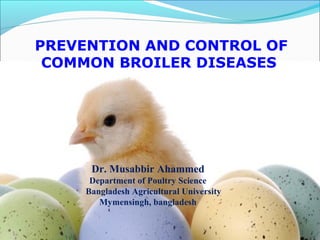
Broiler diseases
- 1. Dr. Musabbir Ahammed Department of Poultry Science Bangladesh Agricultural University Mymensingh, bangladesh PREVENTION AND CONTROL OF COMMON BROILER DISEASES 1
- 2. Types of broiler diseases
- 3. Common viral diseases Marek’s disease Vaccination is carried out at the hatchery with live virus vaccine, either heterologous or homologous or both together, which work to prevent the early multiplication of the field strain in the body and the later appearance of tumours. It is well known that 85% of the flock on average is effectively protected. For this reason we must protect the baby chicks from an early strong infection of the field virus. This Marek’s vaccination is not required for all broilers, but is certainly necessary for the flocks that are killed at an older age.
- 4. Gumboro disease The presence or absence of maternal antibodies will determine the Gumboro vaccine programme. It is very difficult to fix the level of passive (maternal) antibodies in a batch of chicks, since the transmission of antibodies from the parent flock varies widely. The absence of antibodies exposes the chicks to Gumboro disease, whose immunosuppressive effects concerning other infections (Marek, Newcastle, colibacillosis, and salmonellosis) are well known. The vaccination of breeder flocks with inactivated oil–based killed vaccines, transfers a more uniform and long lasting passive immunity to the chicks.
- 5. In farms, create a vaccination program based on the following principles: 1. in the absence of maternal antibodies vaccinate at day 1, use a very attenuated live vaccine and repeat again during the first few weeks – 2. if maternal antibodies are present, vaccinate relative to the decline in maternal antibodies and the type of vaccine used 3. if the maternal antibody level is not known or irregular, vaccinate at day old with a very attenuated vaccine and revaccinate at 3 weeks. In known contaminated farms, the use of new strains of vaccine and a thorough review of the vaccination procedures have been known to improve results. Gumboro disease
- 6. Newcastle disease Protection can be based on: 1. local immunity in particular area where the virus is very virulent 2. general immunity in particular area where the virus is less acute. The use of attenuated live vaccines, followed by inactivated oil–based vaccines gives good immunity. The use of mixed vaccination, an attenuated live together with an inactivated vaccine at day old gives good results in countries where Newcastle disease virulence is high. In countries which are free of the disease, there is no need to vaccinate, especially for standard weight broilers.
- 7. Chronic respiratory disease (CRD) Epidemiologists agree that environmental conditions can cause a greater problem than the disease itself. However, several contaminants can intervene together or separately. 1. Infectious Bronchitis virus Vaccinate at 1 day: the target organ is the Harderian gland. Spraying a full dose of an attenuated strain (0.5 liters of water/1 000 doses), as a course droplet has the same effect as an eye drop and is proven to be efficient. To avoid destroying the virus by heat, this work is best done at the hatchery or in the boxes when the chicks are still confined.
- 8. 2. Mycoplasma Mycoplasma gallisepticum is particularly aggressive. Check the chick quality as well as the possibility of horizontal transmission to/from other birds/sources. Unfortunately, serum tests at this early age are not very reliable. Several cultures must be made to have a statistically reliable result. Mycoplasma synoviae is also a problem, but to a lesser degree. In some countries, the vaccination of parent stock with an inactivated vaccine will produce chicks free of the disease, but which carry antibodies. 3. Infectious swollen head syndrome (Big Head) This infection is caused by a pneunovirus and is present in many countries. A live vaccine can be used for broilers. Vaccinating breeders with an inactivated vaccine will transmit maternal antibodies and delay the appearance of the
- 9. Salmonella Pullorum caused by Salmonella pullorum/gallinarum only originates from a contaminated environment. Strict control of breeding stock over many years has eradicated this problem. Certain salmonella can also provoke health hazards for the consumers, notably Salmonella enteritidis and Salmonella typhimurium. General hygiene measures, control of the raw feed materials, backed up by a well coordinated supervisory programme can be designed to slow down contamination and to separate the contaminated products from the distribution chain. Common bacterial diseases
- 10. Some countries have special rules for salmonella control: 1. specific local standards for poultry houses and equipment that must be approved 2. investigating contamination 3. compensated slaughter of contaminated flocks by the state. Certain countries are considering vaccination. The use of "competitive flora" has also been proposed to reduce the risk of contamination Staphylococcus Usually located in the leg joints, seldom visceral and generally caused by accidental injury or skin lesions, which must be avoided to reduce the incidence of the disease. Salmonella
- 11. Control of bacterial infections Regulations governing the absence of residual chemicals in slaughtered animals are becoming more and more precise in many countries today. The withdrawal periods are becoming longer, which makes it difficult to give treatment late in the life of the flock. The use of permissible additives (expectorants, diuretics, etc.) may limit the problems until slaughter. The choice of treatment is a veterinary decision. It needs for good knowledge of the suitability and availability of the products, an understanding of how to use the product. A bad choice quite often provokes more losses than that caused by the illness itself.
- 12. THANK YOU
